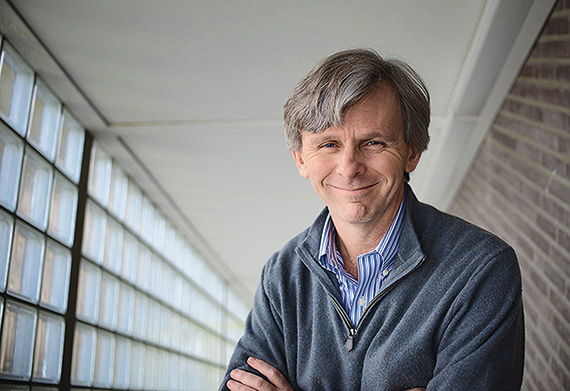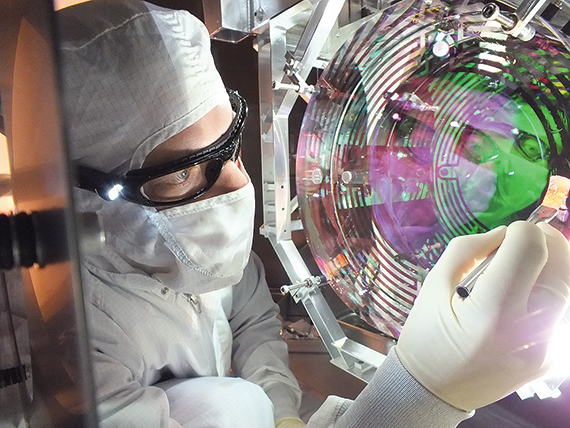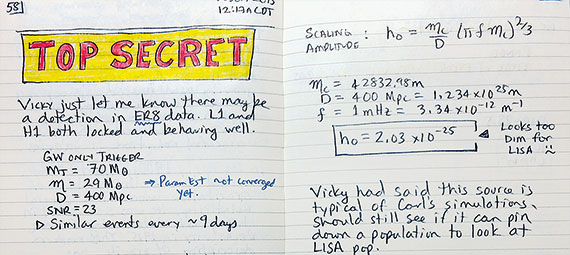
 |
When gravitational waves from the collision of two black holes were detected by both of the twin U.S. Laser Interferometer Gravitational-Wave Observatory detectors at 5:51 a.m. Eastern Daylight Time on Sept. 14, 2015, most scientists involved in the project in the United States were still fast asleep.
Within three minutes of the passing of the gravitational waves, LIGO computer algorithms flagged the detection as something very interesting — and an automated email alert was sent out to three people: two physicists, one at the University of Florida and one at the Massachusetts Institute of Technology, and a postdoc at the Albert Einstein Institute in Hanover, Germany, who just before noon noticed that LIGO had detected an event. By the time the U.S. West Coast woke up, emails were flying around the world as a small group of scientists in the LIGO Scientific Collaboration wondered if this was real or a test.
Northwestern astrophysicist Vicky Kalogera was so caught up in meetings on that Monday she barely had time to look at her email. “I remember thinking there’s something weird going on at LIGO,” recalls Kalogera, an expert in black hole formation in binary systems and LIGO data analysis as well as director of Northwestern’s Center for Interdisciplinary Exploration and Research in Astrophysics. “If only I had a little bit of time to read through the emails.” But the day passed.
“At the end of the day I picked up my 3-year->old, went back home, and I was in our kitchen about to set the table, of course, with the cellphone in my hand, when I received a text message from my former graduate student Ben Farr, who asked, ‘Have you seen the LIGO emails today?’ I said, ‘Yes, I’ve seen them. There’s something strange going on. Is this an injection [a test]?’ He texted back, ‘Loud trigger, baby!’ ”
See "Gravitational Waves: How We Found Them and What Happens Next."
“He doesn’t normally call me ‘baby,’” Kalogera, who was dissertation adviser for Farr ’14 PhD, says with a laugh. “That was the split second that I realized those unusual emails were about a potential discovery.”
But Kalogera still had doubts about the validity of the signal and mulled over the detection for 24 hours before sharing the news — piecemeal — with Northwestern astrophysicist Shane Larson, a fellow member of both the LIGO Scientific Collaboration and CIERA.
“Vicky said something cryptic — ‘Have you seen what’s going on with LIGO,’ ” recalls Larson, who is also an astronomer at Adler Planetarium in Chicago. “She sent me little tidbits all evening, then said, ‘Oh, we think there might be a signal.’ ”
“LIGO made a detection,” Kalogera finally emailed Larson hours later at midnight. “I didn’t believe it at first, but I’m starting to.”
“I was astounded because we thought it might be years before we detected gravitational waves,” says Larson. (See an interview with Kalogera and Larson.)
In reality it was just three days after Advanced LIGO, the most precise measuring device ever built, was fired up after a major five-year upgrade.
But it would be five months before the LIGO astrophysicists let the rest of the world know about the greatest discovery in the modern age of astronomy, namely that through the detection of gravitational waves from two black holes that collided in a cataclysmic event 1.3 billion years ago, scientists now had a new way to probe the farthest reaches of the universe — perhaps all the way back to the Big Bang.
On the morning of Feb. 11, LIGO and the National Science Foundation shared the stunning discovery with a large media contingent at the National Press Club in Washington, D.C., as tens of thousands watched over the Internet.
“Ladies and gentlemen, we have detected gravitational waves,” announced exuberant Northwestern alumnus David Reitze ’83, LIGO executive director at the California Institute of Technology in Pasadena. “We did it! It’s the first time the universe has spoken to us in gravitational waves.”
By measuring the tiny disturbances gravitational waves make to space and time as they pass through the Earth, scientists observed ripples in the fabric of spacetime from the collision of two black holes in the distant universe. Based on signals received at the LIGO observatories in Louisiana and Washington, physicists concluded that the gravitational waves were produced during the final fraction of a second of the merger of two black holes to produce a single, more massive, spinning black hole.

Laser physicist Dave Reitze ’83, executive director of the Laser Interferometer Gravitational-Wave Observatory at the California Institute of Technology in Pasadena. Photo by Traci White.
The discovery confirmed a major prediction of Albert Einstein’s 1915 general theory of relativity (see “Einstein and Gravitational Waves”).
According to general relativity, a pair of black holes orbiting each other lose energy through the emission of gravitational waves, causing them to gradually approach each other over billions of years, and then much more quickly in the final minutes. During the final fraction of a second, the two black holes collide into each other at nearly one-half the speed of light and form a single, more massive black hole, converting a portion of the combined black holes’ mass to energy, according to Einstein’s formula E=mc2.
The discovery was made possible by the enhanced capabilities of Advanced LIGO, an ongoing major upgrade to the observatories that is increasing the sensitivity of the instruments so that, for example, LIGO can now see binary black holes at an average distance of 2 billion light years.
Finding gravitational waves is “really a triumph of science and human ingenuity and tenacity,” says Reitze, a laser physicist who has been involved with LIGO since 1996. “It’s so cool that we can make devices that are capable of measuring these tiny, tiny effects that come from these massive cataclysmic collisions of black holes.
“Gravitational waves were something that Einstein predicted 100 years ago. It took 100 years for people to figure out a way to measure something that small. What we saw was unique. Nobody ever saw a pair of black holes colliding before.”
But the discovery depended on the work of scientists and engineers across many disciplines over many decades. “It’s a story of collaboration; it took more than a thousand people to make it happen,” adds Reitze, referring to the hundreds of scientists from universities and research centers in the United States and 14 other countries around the world who are active today in the LIGO Scientific Collaboration, and another 250 researchers in the European-based Virgo Collaboration that operates an interferometer near Pisa in Italy.

A technician at work in the Livingston, La., observatory. Photo courtesy of the California Institute of Technology.
Kalogera leads the LIGO research team at Northwestern, which currently includes Larson, Selim Shahriar (an electrical engineering professor who is working to improve the detectors’ sensitivity), two postdoctoral fellows, three graduate students and several undergraduate students. The team’s contributions to the Sept. 14 discovery include making predictions for anticipated detections, interpreting the astrophysics, analyzing the data and characterizing the detectors. (The Northwestern community members who are co-authors of the gravitational-wave discovery paper shared two significant honors: the $3 million Special Breakthrough Prize, recognizing extraordinary scientific achievement, and the 2016 Gruber Foundation Cosmology Prize, recognizing a discovery leading to fundamental advances in understanding the universe. Read more about the two awards.)
Up until now almost everything we know about the universe has come from electromagnetic waves — light we can see — such as X-rays, gamma rays and radio waves, says Kalogera, who is one of LIGO’s most senior astrophysicists.
“But the detection of gravitational waves marks a new beginning for how we study the universe,” she says, “very much like the first time Galileo looked through his telescope to see the cosmos, instead of just with his eyes.”
Until last September, a pair of black holes had only been studied in theory and on computers. “Now we know that a lot of our theoretical models for black holes are actually correct,” she adds. “That’s part of the work I was doing early in the astrophysics, trying to model what happens to black holes when they form and exploring whether they become LIGO sources.
“We also have pushed, just with this one discovery, the boundaries of where we are testing Einstein’s theory of general relativity. Gravitational waves allow us to look at the strongest gravity environments that are unreachable in any lab.”
“This is a new kind of astronomy — observing the universe using gravity itself,” adds Larson. “We can’t ‘see’ black holes with telescopes. A black hole’s gravity is so strong, not even light can escape it. But black holes do radiate gravitational waves, which are produced by accelerating masses. This is the first time black holes have been directly detected by measuring them through their gravity, as opposed to measuring the effect they have on other matter in the universe.”
Many scientists, even particle physicists, say that this discovery is bigger than the Higgs boson.
“I think there’s some truth to that,” agrees Reitze. “The Higgs boson was an ending, if you will, for the standard model of particle physics. It was predicted in the ’60s, they searched for it for a long time. And they got it. So you could check off a box and say, ‘OK, we’ve now filled in the last bit of the standard model.’
“The discovery of gravitational waves is completely the opposite of that. It’s the beginning. So there’s a whole lot of discovery space out there. In that sense, I think it is bigger than the Higgs boson. We’re not putting an exclamation point on the theory. We’re actually starting a new kind of exploration of the universe.”
When Reitze, Kalogera and scores of other scientists first heard about the Sept. 14 detection at LIGO, many were skeptical. Because LIGO had just started up after a five-year upgrade, most thought the event was a test.
“We have this protocol for testing our own ability to detect gravitational waves,” explains Reitze.
“They’re called blind injections. We have a way of simulating a gravitational wave in our detectors by basically wiggling a mirror. And doing it in the same way at both interferometers so that an analysis algorithm would look at it and recognize it as a real gravitational wave. We had intended to do these blind injections during the first run, which we were about to start.”
So the first thing Reitze thought when he heard about the detection was that somebody probably injected something and didn’t flag it. “These blind injections are carried out in a super-secret environment,” adds Reitze, “so only a very few people actually know what’s going on — the people who do the injections and me, as the director of the lab.”
Once he confirmed that there were no blind injections that day, he concluded the detection was real.
“People were stunned at how good this signal was,” says Reitze. “Rai Weiss called it a monster — an amazing signal.” (Rainer Weiss, a professor of physics emeritus at MIT, invented the laser interferometric technique that is the basic operation of LIGO. See “Einstein and Gravitational Waves,” page 19.)
The next step was for the LIGO collaboration leadership to run through its checklist of more than 100 items to analyze the data from the observatories and do multiple simulations, reviews and months of additional checking — to confirm the discovery of the monster signal.
“We’re very paranoid in this business because we don’t want to make a false claim,” says Reitze. “This is a complex endeavor. We didn’t want to make a statement until we were convinced that we were right.”

Minutes after learning about the discovery, Shane Larson scribbled calculations in a notebook to try to figure out if a similar black hole system might be visible to other gravitational wave detectors.
So that meant the 1,000-plus scientists in the LIGO collaboration had to keep the news a secret — from everyone outside the group (including other colleagues and researchers, and spouses, family members and friends). The collaboration leadership was constantly reminding people to be careful.
But “it’s very hard to hide these things from your partner when they’re in the same line of work,” Kalogera says. “It happens that my husband [Fred Rasio] is also an astrophysicist at Northwestern — I couldn’t hide certain things from him, like my work schedule, which became impossible very quickly. I was working around the clock and I kept asking him to take care of the kids. He knew that there was something very important going on with LIGO. But for many months, I didn’t share what.
“My husband is the lead scientific editor of the Astrophysical Journal Letters, in which we eventually published one of the LIGO papers, the one that discussed the astrophysical implications of the discovery. But we had developed, because of his editorial responsibility, a clear understanding that there are things from work that we don’t talk about. So we’re used to keeping professional secrets.”
While LIGO scientists analyzed the data and prepared scientific papers on the detection of gravitational waves, news of the discovery began to leak out. Within days of the Sept. 14 event, an astrophysicist at Arizona State University twice tweeted that LIGO had detected gravitational waves.
“A lot of people came to our defense and said, ‘Don’t rush them; let LIGO do their due diligence,’ ” explains Reitze. “There was a standard stock phrase: ‘We’re just starting a run. We’re looking at the data. We’re analyzing it. We’ll have something to say in a few months.’ ”
In the end, once the LIGO team submitted the paper to Physical Review Letters, the world’s premier physics letter journal, somebody managed to get a copy of it. “At that point the cat was out of the bag,” says Reitze. “We debated whether we were going to cancel the press conference.”
But they didn’t. And the media coverage of the discovery was tremendous. The gravitational waves story was featured widely in multimedia outlets around the globe, including in-depth coverage in the New Yorker, the New York Times, the Washington Post, the Times of London and all the science media as well.
“We were overwhelmed by the media attention,” says Reitze. “Between the announcement on Thursday, Feb. 11, and the following weekend, I got 1,200 emails — congratulatory notes, requests for interviews and invitations to give talks.”
“The first 24 hours I think I did more than a dozen interviews,” says Kalogera. “We were on the front page of the New York Times, above the fold, so not just the Science section!” Kalogera, who was born in Greece, even received a congratulatory phone call from the country’s president and an invitation to meet with him the next time she’s in Athens.
LIGO stopped running on Jan. 12. The collaboration team had presented only half the set of data by the press conference, so the scientists are now analyzing the rest. They’re also making improvements to the sensitivity of the LIGO detectors.
“In the first run — the run that detected the gravitational waves — we were operating at 30 to 40 percent of our design sensitivity,” says Reitze. “When we get to our full design sensitivity, we should be seeing these kinds of events every few days. We’ll keep on the improvement program until July or August and then we’ll go on another run — for six months.”
With the potential for even greater detection on the immediate horizon, it’s a heady time for scientists who study the cosmos.
“We’ve been wandering around in the desert for 40 years looking for the promised land,” says Reitze of the search for gravitational waves. “Then boom! We made it. Now we have to explore it.”
Stephanie Russell is the editor of Northwestern magazine. Megan Fellman, Erin Karter and Kristin Samuelson of the Department of University Relations contributed to this story.
The LIGO team of scientists and engineers detected gravitational waves for a second time. Read all about the latest discovery.
Read more about the discovery of gravitational waves and see an interview with Vicky Kalogera and Shane Larson.
Take a 1.3 billion-year journey with LIGO scientist David Reitze and see how the gravitational waves made it to Earth.
The Northwestern community members who are co-authors of the gravitational-wave discovery paper shared two significant honors: the $3 million Special Breakthrough Prize, recognizing extraordinary scientific achievement, and the 2016 Gruber Foundation Cosmology Prize, recognizing a discovery leading to fundamental advances in understanding the universe. Read more about the two awards.
Tell us what you think. E-mail comments or questions to the editors at letters@northwestern.edu.